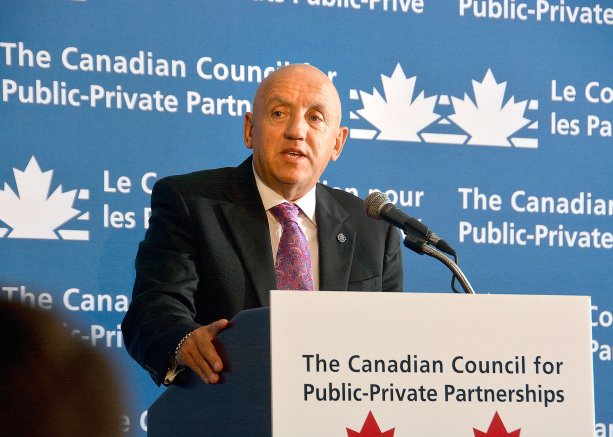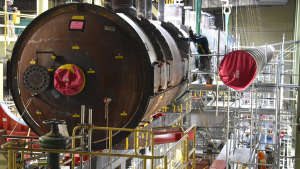Duncan Hawthorne says when he looks at the arguments for embarking on a public-private partnership (P3) he can’t think of a better case study than his firm Bruce Power.
"When we took on these sites, the expectation was that everything on the Bruce site would have been dead by 2018 because there were only four units in operation," says Hawthorne, Bruce Power president and CEO.
"So had we not taken over this site…a facility that’s now the world’s largest, and I would argue one of the world’s best, would have ceased to exist in the next three years."
A jointly produced report from Bruce Power and the Canadian Council for Public-Private Partnerships (CCPPP) highlights the company’s achievements over the past 14 years with the P3 structure as well as some challenges along the way.
Hawthorne recently gave an address on Powering the Future of P3s at an event hosted by the CCPPP.
Formed in 2001, Bruce Power is a partnership with Borealis Infrastructure Management (a division of the Ontario Municipal Employees Retirement System), TransCanada, the Power Workers’ Union and the Society of Energy Professionals. A majority of Bruce Power’s employees are also owners in the business.
Located in Tiverton, Ont., on the shore of Lake Huron, Bruce Power is the source of roughly 30 per cent of Ontario’s electricity and has eight reactors. It has been the single largest source of Ontario Building Trades work in the province over the last 10 years.
"When we came here to Ontario to look at the Bruce site, it was part of a competitive process," Hawthorne explains, adding the first challenge was taking a look at the decommissioning fund.
When reactors reach their end-of-life the cost to decommission the site has already been set aside.
"The decommissioning fund had no cash in it. The question was, how could we make the transaction work?" Hawthorne explains. "The idea of finding a model that could deal with that, and still achieve, both on the government’s ends and our ends, required us to put our thinking caps on. That’s where the notion of a public-private partnership came from."
An agreement was reached for the lease of the facility along with a series of ancillary agreements.
"In addition to leasing the power plants and related systems, Bruce Power also acquired nuclear fuel and other assets. The initial lease term was for 18 years plus options to extend up to an additional 25 years. It included lump-sum payments including the first one on the date Bruce Power was formed — May 11, 2001 — for $370 million," the study reads.
Once the agreement was reached, Hawthorne says the next step was gaining public confidence.
"The population at large are very nervous about privatization…and particularly when you add the word nuclear into it," he states. "The thing about the Bruce site, which was very unique for me, was it’s a close knit community. When the Bruce transaction occurred, it occurred at a time when it was a very depressed area. There was a willingness to try and do something different. We were able then to talk about what we wanted to do together."
When it comes to the arrangement, the site is leased from the province and all of the assets remain publicly owned. Bruce Power is responsible for operating and investing in the units, including refurbishment and maintenance costs.
"As one of the largest P3s in Canada and the first involving nuclear power generation, Bruce Power is a unique model for future P3s in the global energy sector," says Dale Richmond, CCPPP chair in a statement.
The company has invested $10 billion of private money into the site, the study reads, and doubled the operational units from four to eight.
Hawthorne states that during the refurbishments of Units 1 and 2, some interesting technologies were used in order to replace major components such as the reactor core, steam generators, feeder tubes and electrical systems.
"(It) involved cutting through massive concrete barriers in order to get to its generators and pull them out. It involved developing state-of-the-art robotics so that we could dismantle the reactors robotically. It was a feat of engineering," he states. "Over the course of our short history, I think we’ve challenged ourselves to do things that people didn’t think could be done. We’ve restarted units, we’ve rebuilt units, we’ve changed the way the units operate, we’ve extended the life of the units."
But the biggest challenge, Hawthorne states, was not the plant itself, but rather dealing with the employee demographic. In 2001, only 10 per cent of staff was under the age of 35, with 44 per cent between 46 and 55, the study reads.
"We had to reverse that quickly," Hawthorne says, adding they turned their focus to recruitment, training and apprenticeships. As of 2014, 33 per cent of employees were under 35, while the number of staff 46 to 55 dropped to 30 per cent.
Bruce Power is also looking to embark on another massive investment, the refurbishment of six units.
Hawthorne says the cost of the refurbishment is about $15 billion and is expected to take place roughly over the next 20 years. A start date hasn’t been confirmed.
"It’s a lot of work for the industry. It’s a continuous plan. It’s not kind of a boom and bust cycle," he adds.
The success of Bruce Power’s P3 structure is something to celebrate, Hawthorne says, and the perception of the public on this funding model needs to change.
"Whenever government discusses the possibility of doing things, you usually see the same commentary. If the private sector gets involved they’re going to put profit motive above other things and that will be a reduction of quality on the service or cost cutting inside the business," he states. "There’s an expectation that in order to make money you’re going to cut corners. They kind of miss the point of the longer term strategy that investors have."




Recent Comments
comments for this post are closed